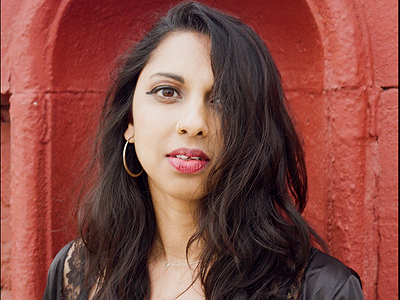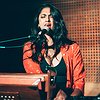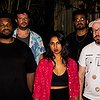Part 1
Name: Amirtha Kidambi
Occupation: Vocalist, composer, multi-instrumentalist, educator, activist, organizer
Nationality: Indian-American
Current release: Amirtha Kidambi's New Monuments is out March 15th 2024 via We Jazz. The album features the band Elder Ones, comprising Matt Nelson (Soprano Saxophone, Effects), Lester St. Louis (Cello, Electronics), Eva Lawitts (Bass, Effects) and Jason Nazary (Drums, Modular Synthesizer).
[Read our Jason Nazary interview]
If you enjoyed this Amirtha Kidambi interview and would like to know more about her music, visit her official homepage. She is also on Instagram.
Over the course of her career, Amirtha Kidambi has collaborated with or performed works by a wide range of artists, including Matt Evans, Darius Jones, Matana Roberts, Trevor Dunn, Lea Bertucci, Max Jaffe of JOBS, Ben Vida, and Tomas Fujiwara.
[Read our Matt Evans interview]
[Read our Darius Jones interview]
[Read our Matana Roberts interview]
[Read our Trevor Dunn interview]
[Read our Trevor Dunn interview about improvisation]
[Read our Lea Bertucci interview]
[Read our JOBS interview]
[Read our Ben Vida interview]
[Read our Tomas Fujiwara interview]
When did you first start getting interested in musical improvisation?
It’s hard to say because I’m pretty sure I was always improvising. As a kid I was constantly singing, hitting something, and making sounds and songs.
Improvisation is a deep part of the Indian musical tradition, so I was always aware of it in the South Indian Carnatic music, which I was immersed in as a bharatanatyam dancer, with records playing in the house or attending concerts with my mom. I grew up singing a call-and-response song devotional song form called bhajan starting around age 3, where there is a leader and each line of the song is repeated by the group. You might have heard a version of these on the Alice Coltrane devotional records such as Turiya Sings.
It wasn’t just for musicians, but a community practice, though there were members of our group who were quite virtuosic improvisers. When those uncles or aunties lead the group and extrapolate within the melodies, it would really excite me and it was something everyone did to varying degrees. I guess I probably started in that setting when I began leading bhajans.
Once I left my community and went to college, getting deeper into the study of Western classical music, it fell away as part of my practice, though I was very interested in early music of Europe and how improvisation was part of that music. I was listening to a lot of jazz then too, but I hadn’t really performed it since I was in high school bands.
When I moved to New York from California, I was starting to pull away from the classical new music scene and began to tap into the incredible community of improvisers quite naturally, having sessions and meeting people. I was always attracted to it but formal training kind of beat it out of me, so it was really about returning to something that was always part of me rather than discovering something new and as a reaction to the strictures of Western classical music.
Which artists, approaches, albums or performances involving prominent use of improvisation captured your imagination in the beginning?
Apart from Indian music, Cecil Taylor. I remember the moment I first saw a video of free improvisation and it was Cecil in the “Imagine the Sound” film. I was listening to a lot of jazz in high school and was deep into John Coltrane, and I remember listening to Interstellar Space in our public library on CD and being attracted to it, but not quite understanding it yet.
Then in college I came back to it, 70s Miles, Ornette, Ayler, and developed an interest through recordings. Watching the Imagine the Sound film was like being struck by a lightning bolt.
Seeing Cecil with the white background with close-ups of his hands and being shot from above, his wild kinetic energy. I don’t think I had seen a live performance of someone playing totally free yet, in person or in a video and watching the process of making something from nothing, of building the energy and form, introducing and developing ideas, it made total sense to me. I knew I wanted to see more and be around it.
But I didn’t think it was something I could do until a while later because I didn’t know many people personally who did it. I had a really full circle moment when Cecil passed in 2018 and William Parker called me to sing at his funeral service, which was such an intense honor.
Focusing on improvisation can be an incisive transition. Aside from musical considerations, there can also be personal motivations for looking for alternatives. Was this the case for you, and if so, in which way?
Turning to improvisation for me was kind of a process of decolonizing myself. I had studied Western classical music not by choice, but by default, because that is what was available at my college.
As I continued, I became interested in the avant-garde, because of how it pushed the boundaries of sound, but it was still always so hierarchical in the new music world. The composer was the authority and as a performer, I basically had no freedom or agency. My vocal timbre had become so contorted into being a sort of standard mezzo-soprano and I was dying to break out of it, which I was always doing in rock bands, but I was craving even more freedom.
As I got more frustrated by my role in classical music, I began to look to models like the Art Ensemble and the AACM, not just musically but also their underlying political imperatives, collectives which was the cultural arm of the Black Power movement. It was grappling with social questions of marginalized people and everyone in the group had agency to write, create, improvise their own individual sound within the collective and in interdisciplinary ways.
Improvisation was a critical tool for me in finding my voice as someone on the margins, as an Indian-American who was not at that time (around 2009) represented in American music other than Vijay Iyer. It was a way for me to go back to my roots and not only find my voice as a singer, but also access my creative voice as a composer.
What, would you say, are the key ideas behind your approach to improvisation? Do you see yourself as part of a tradition or historic lineage?
I see myself in the lineage of “Creative Music” because it is such an expansive practice and had such a fundamental role in me finding my artistic voice.
I had always been influenced by horn players, maybe because they are essentially imitating a human voice so it was Coltrane and Albert Ayler for me and people in the NYC music scene like Darius Jones whose free jazz-punk band Little Women was my favorite. He had an incredible impact on me as a collaborator in his music.
Vocalists are so underrepresented in the tradition, so it took a while before I saw people really doing that. Seeing Abbey Lincoln and Max Roach videos was formative, and I think of her, Jeanne Lee, Linda Sharrock, Maggie Nicols and others as being predecessors. I consider my contemporaries folks like Fay Victor, Shara Lunon, Charmaine Lee, Gelsey Bell, Isabel Crespo Pardo, Edi Kwon and others.
It’s actually incredible to see how much the tradition has grown and I think vocalists are some of the most creative people in the scene right now. People need to be paying attention to that and working with them more.
What was your own learning curve / creative development like when it comes to improvisation - what were challenges and breakthroughs?
Although I loved the experience of doing it, I remember it being such a struggle in the beginning. There were many times that felt like failures, but I think that is so inherently part of the process of getting better.
It was also crazy in New York to immediately be playing with all these heavy people. Early on I got to do things with Muhal Richard Abrams, Matana Roberts, Darius Jones and of course Mary Halvorson. I remember having a trio with Trevor Dunn and Shahzad Ismaily, and Tyshawn Sorey asking me to play duo at The Stone for his residency!
That was actually insane, because it was probably the first time I played an hour-long set in such an intimate format. He switched throughout the set from drums to trombone to piano. I felt like I had some huge breakthroughs that night alone, because it pushed me to really introduce ideas and commit, allow for space and listen deeply. Tyshawn is such an incredible improviser and I looked up to him so much. It felt like a big deal for him to ask me to do that and treat me as an equal even though I was so early in my journey. It really pushed me to another level.
I’d say the same for playing with Ambrose Akinmusire in Mary’s band, when he would be soloing and the gesture over to me to come in with him, which was such an incredible learning experience and to figure out how to improvise in Mary’s incredibly complex compositions.
Tell me about your instrument and/or tools, please. How would you describe the relationship with it? What are its most important qualities and how do they influence the musical results and your own performance?
In my band Elder Ones, I use the full range of my tools with my voice, electronics, synthesizer and the Indian harmonium. I grew up singing with Indian harmonium, which is a hand pumped reed-organ in a devotional setting and it has a meditative quality to it. Sometimes I use it idiomatically as a drone and other times I play bass lines or chords as if it’s a synth.
Adding synthesizer expanded the sound palette further, but I loved how the very acoustic qualities of the harmonium could be juxtaposed with the synth. I always opt for very warm analog synth sounds. I’ve always explored the absolute fullest range of my voice, using all kinds of sounds and what I call “timbral techniques” like screaming, breath, percussive sounds etc.
In the last few years I’m really extending this further through electronics utilizing feedback, delays, bitcrusher, finding ways to take my voice into totally inhuman and visceral places.







